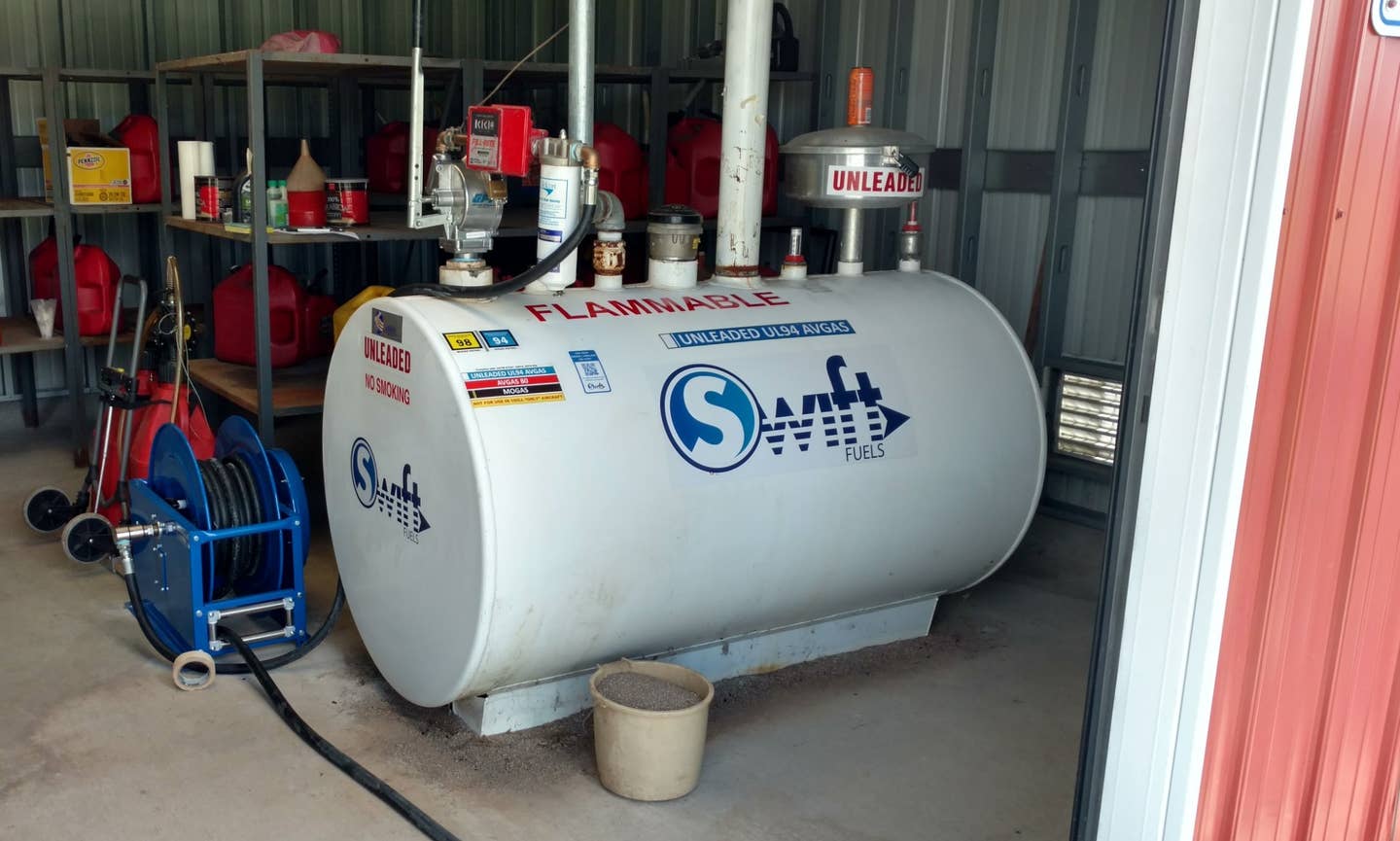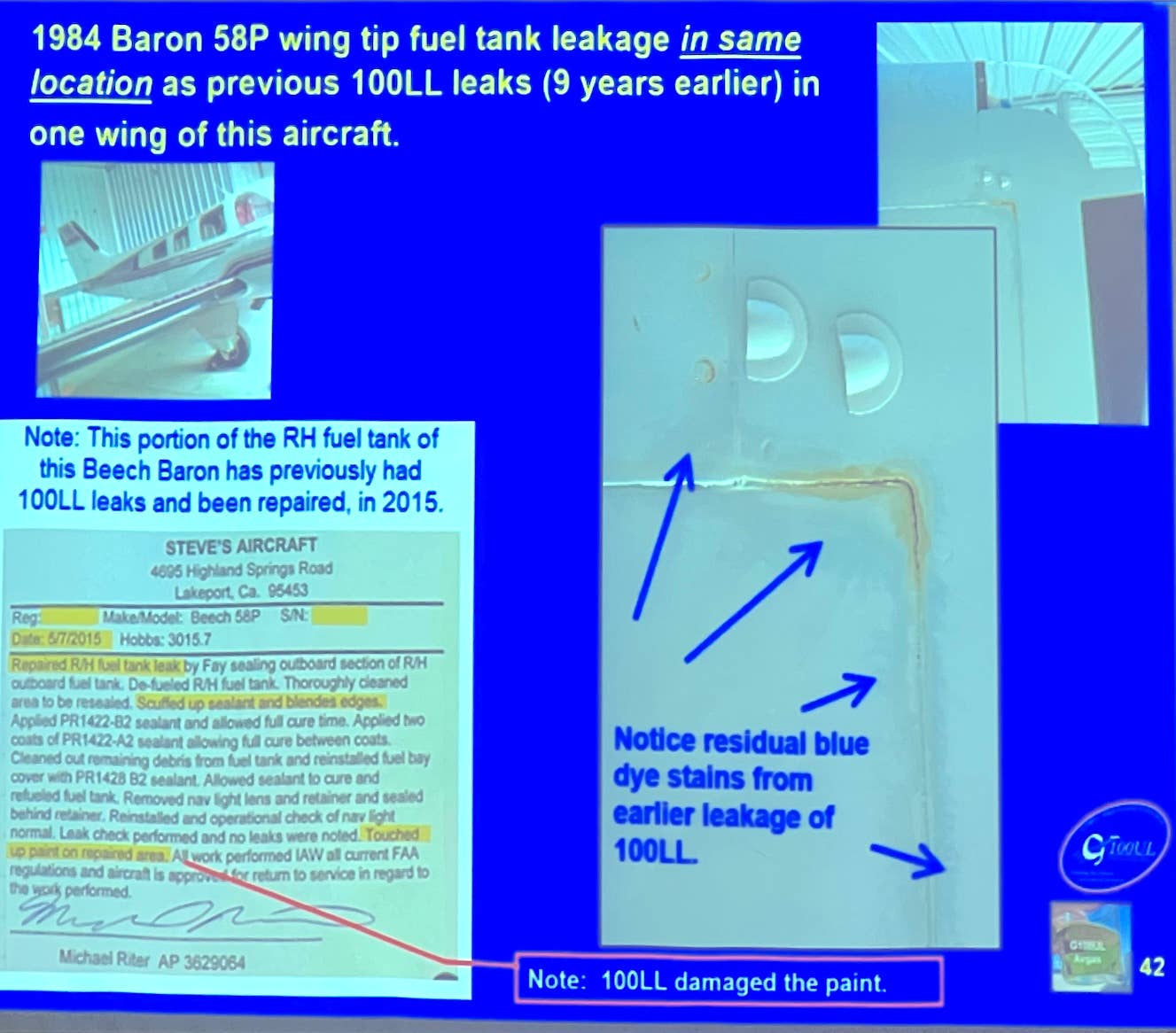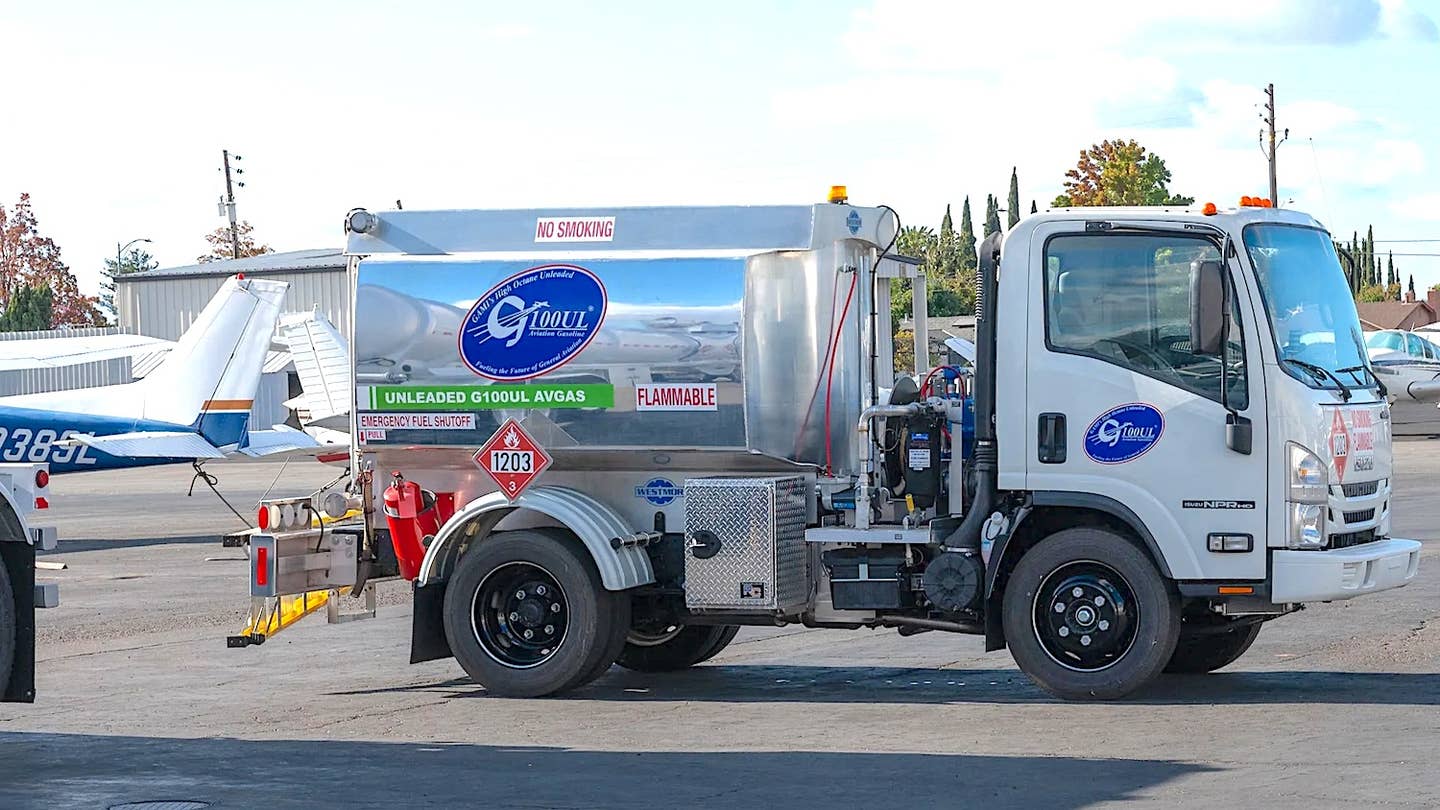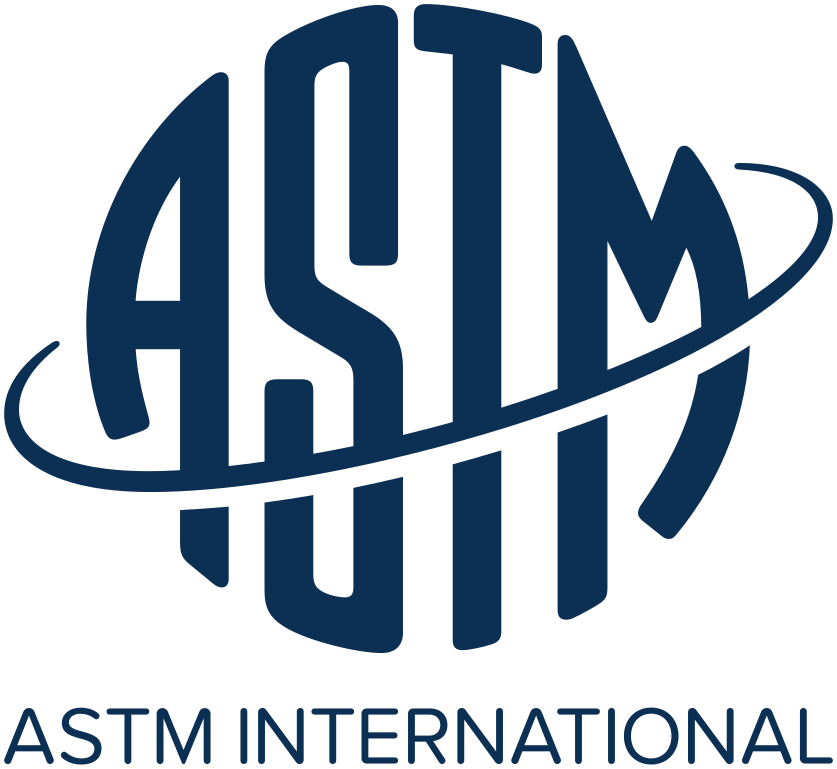Aviation Life Rafts, Part Four:Double-Tube Life Rafts
As winter is upon us in North America, now’s the time to make that vacation trip to warmer, more relaxed climes. But such flights often involve long overwater legs and bring with them their own challenges, not least of which is which equipment to add to your load. AVweb Special Projects Editor Doug Ritter – whose Equipped To Survive Web site offers the most comprehensive online resource for independent reviews of outdoors gear and survival equipment – assembled this in-depth, four-part look at aviation life rafts. In this final installment, he takes a close look at the more desirable double-tube rafts. Don’t miss this detailed product review … and don’t leave home without one.

 In this four-part series, AVweb provides an in-depth look at aviation life rafts. We examine the regulatory requirements, the common-sense requirements and what you should look for when selecting a life raft. We also examine both the approved and unapproved rafts for the GA market and let you know which ones will more likely save your life if you ever need to use them. In this four-part series, AVweb provides an in-depth look at aviation life rafts. We examine the regulatory requirements, the common-sense requirements and what you should look for when selecting a life raft. We also examine both the approved and unapproved rafts for the GA market and let you know which ones will more likely save your life if you ever need to use them. |
 The primary market for double-tube Type I life rafts are larger corporate and transport-category aircraft. Most pilots of light GA aircraft will find them too heavy and expensive for their tastes. However, one of the unapproved basic double-tube rafts will provide far greater redundancy than a single-tube raft for not much of an increase in weight or bulk.
The primary market for double-tube Type I life rafts are larger corporate and transport-category aircraft. Most pilots of light GA aircraft will find them too heavy and expensive for their tastes. However, one of the unapproved basic double-tube rafts will provide far greater redundancy than a single-tube raft for not much of an increase in weight or bulk.
For any pilot considering long over-water flights where conditions on the water are likely not very hospitable and rescue likely many hours or days away, a well-equipped double-tube raft should be at the top of your shopping list.
Air Cruisers Company
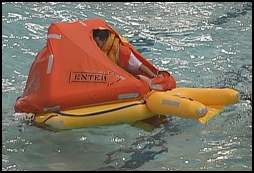 Air Cruisers, new to the GA market, has been making rafts and slide rafts for transports for years. They sent a 4-person and a 13-person Type I (double-tube) TSO'd raft. The smaller is hexagonal while the bigger one is round. Both have a single-arch canopy, but neither stayed erect when we failed the upper tube. Except for under the arch, both were deemed uncomfortable, though the 13-person was much better because the large 12-inch tubes and its larger diameter give better geometry. They are equipped with a thin closed-cell foam floor for insulation that proved unable to take even the minimal abuse of our short test before being ripped up.
Air Cruisers, new to the GA market, has been making rafts and slide rafts for transports for years. They sent a 4-person and a 13-person Type I (double-tube) TSO'd raft. The smaller is hexagonal while the bigger one is round. Both have a single-arch canopy, but neither stayed erect when we failed the upper tube. Except for under the arch, both were deemed uncomfortable, though the 13-person was much better because the large 12-inch tubes and its larger diameter give better geometry. They are equipped with a thin closed-cell foam floor for insulation that proved unable to take even the minimal abuse of our short test before being ripped up.
An inflatable ramp-style entry aid, attached between tubes on the smaller raft and on the bottom tube on the larger, proved a mixed bag for testers. While some praised it, others had extreme difficulties. Heavier persons in particular had problems as the ramp collapsed under them. Some found it impossible to board over the high-freeboard double tubes of the 13-person without assistance, even with the lightweight inside boarding ladder to help. The 4-person, with only 8-inch tubes, has a one-inch webbing line running across the raft with loops attached that proved somewhat difficult to grasp and would be very difficult in cold weather.
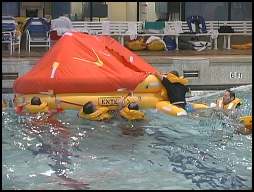 One person, grabbing hold of the canopy to help pull himself on board, ripped it open. The very lightweight zippers on both entry flaps failed completely on the 13-person, and later in testing one of the zippers on the 4-person got jammed, rendering the canopy useless for protection from the elements. The inflatable entry also doesn't appear to meet the requirements of TSO-C70a, para. 4.6: "Puncturing of inflatable boarding aids must not affect the buoyancy of the raft buoyancy chambers."
One person, grabbing hold of the canopy to help pull himself on board, ripped it open. The very lightweight zippers on both entry flaps failed completely on the 13-person, and later in testing one of the zippers on the 4-person got jammed, rendering the canopy useless for protection from the elements. The inflatable entry also doesn't appear to meet the requirements of TSO-C70a, para. 4.6: "Puncturing of inflatable boarding aids must not affect the buoyancy of the raft buoyancy chambers."
The raft knife on the 13-person raft would not reach the mooring/inflation line, the tether was 48 inches too short, and the fitting on the manual inflation pump did not match the raft's topping valves, rendering the pump useless. The attached cap on the recessed valves made use of the correct pump, in the 4-person, extremely difficult. There was also no immediate inflation handle, a feature we prefer.
The 4-person raft has a trio of narrow-tapered ballast bags while the 13-person is fitted with four (approximately 65 lbs. each, 195 and 260 lbs. total, respectively), which are inadequate in our opinion. The large drogue (sea anchor) proved very capable, though it had no swivel and only a too-short 14-1/2 ft. line. The larger raft provided only 3.36 sq. ft. per person, the only raft we reviewed that did not meet the already minimal standard of 3.6 sq. ft. in the TSO. Besides assuring us that it did meet the standard, Air Cruisers told us it also meets the requirements of the TSO via the alternative compliance methods provided (para. 4.1.1). It may, but it's too small in our opinion.
The Survival Equipment Pack (SEP) is on a tether and must be retrieved from the water, which isn't immediately obvious due to poor placarding. We found a number of food packages ruptured or damaged, apparently in packing the raft, and the food already spoiled in one instance. The 13-person raft was vacuum-packed, an option ($300) for when space is at a premium, and a feature we like for the added protection it offers.
Included are two storage bags on the 4-person raft, 3 larger bags on the 13-person, of envelope construction and 12 x 11 inches and 23 x 11.5 inches, respectively. The flap is secured with either two or four metal snaps, depending on size. This flap also serves to attach the bags to the interior grab lines, compromising their effectiveness. To say this arrangement was not highly regarded would be an understatement.
A Word About Servicing
One of Air Cruisers' big selling points has been that these rafts only need to be serviced every six years, compared to the industry standard of annually. However, it turns out that isn't exactly the whole story. Because they use a composite-wound cylinder, it must be hydro-tested every three years. Air Cruisers explained that while the raft valise must indeed be opened up and the cylinder removed for testing and then reinstalled, the raft itself doesn't need servicing. While Air Cruisers may be comfortable performing this procedure and then certifying the raft as good to go, two respected stations we checked with wanted nothing to do with the procedure. That may change as experience is gained with these new products, but be warned you may have to send it to Air Cruisers for service. In any case, that's still a year longer than anyone else in the industry, two more than most.
However, there's more. Air Cruisers also claims that the PUR Survivor 06 Manual Reverse Osmosis Desalinator in the Part 135 SEP requires service only every three years and has a letter from PUR that can be interpreted to support that claim. Based on our experience with this product, we were skeptical and after we started investigating the subject, PUR reviewed the matter and issued a policy letter to clear up any questions. It says that two years is the maximum recommended service interval for civilian aviation use.
Nathan Mueller, PUR's Associate Product Manager, told us Air Cruisers is free to ignore that recommendation, but PUR will not support it. Moreover, PUR advised us that such an extended service interval is more likely to result in the need to replace expensive components of the 06 when it is serviced, significantly increasing the cost of service. Based on PUR's recommended service interval, a raft equipped with the Part 135 SEP should be opened at two-year intervals to service the 06, meaning that during the claimed six-year raft service interval, the pack would actually need to be opened at two, three, and four years for service. As noted, Air Cruisers maintains three years is acceptable and is not altering their service schedule.
The effort to reduce weight on these rafts was obvious, sometimes painfully so. We were taken aback by Air Cruisers' Al Wigert's explanation that their number-one priority was reduced weight, followed by price. When we asked where performance stood, he told us it came after those. He explained that while that "wouldn't be the priority (ranking) of the crews" who might someday have to depend upon the rafts, that was "clearly the priority of the manufacturers" who are their primary customers.
BFGoodrich Aerospace Aircraft Evacuation Systems
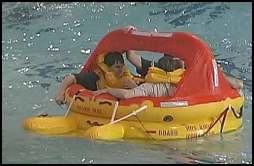 BFGoodrich sent us both a four-person and a 12-person Type I approved raft. Both rafts incorporate BFG's unique boarding platform, a swath of fabric slung between two inflatable outriggers sticking out from the side of the raft's bottom tube, one on the 4-person, a round raft (nearly), one on either end of the 12 person, a long rectangle with round ends. A number of grab handles and a lightweight interior boarding ladder are also provided. These boarding aids, combined with relatively low 18-inch total depth, made boarding pretty easy for the most part. However, this entry also doesn't appear to meet the requirements of the TSO's paragraph 4.6.
BFGoodrich sent us both a four-person and a 12-person Type I approved raft. Both rafts incorporate BFG's unique boarding platform, a swath of fabric slung between two inflatable outriggers sticking out from the side of the raft's bottom tube, one on the 4-person, a round raft (nearly), one on either end of the 12 person, a long rectangle with round ends. A number of grab handles and a lightweight interior boarding ladder are also provided. These boarding aids, combined with relatively low 18-inch total depth, made boarding pretty easy for the most part. However, this entry also doesn't appear to meet the requirements of the TSO's paragraph 4.6.
The smaller raft has only a single-arch canopy, which elicited lots of negative comments. The 12-person is equipped with a unique canopy support system, a pair of hoops at either end of the straight sections, joined by a central tube. This provides the most spacious headroom of all the rafts we tested. Large zippers make closing up the rafts fairly easy, but lack of adequate storm flaps meant they leaked in our simulated storm conditions. Both canopies stay erect if the upper tube fails.
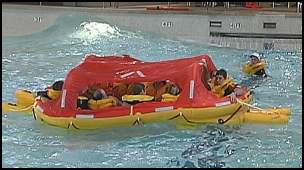 BFG's four small ballast bags (49 lbs. ea., 196 lbs. total} are inadequate for the larger rafts and five drain holes make them even less effective. Moreover, the drogue attach point failed on the 12-person, which could be disastrous in heavy seas, allowing the long raft to broach and easily capsize given the inadequate ballast. According to BFG, analysis showed the failure was the result of substandard bonding, an assembly error. While the drogue is always an important contributor to a life raft's stability, for a boat-shaped raft the sea anchor is essential. The rafts are available in sizes for 4, 8, 10 and 12 persons.
BFG's four small ballast bags (49 lbs. ea., 196 lbs. total} are inadequate for the larger rafts and five drain holes make them even less effective. Moreover, the drogue attach point failed on the 12-person, which could be disastrous in heavy seas, allowing the long raft to broach and easily capsize given the inadequate ballast. According to BFG, analysis showed the failure was the result of substandard bonding, an assembly error. While the drogue is always an important contributor to a life raft's stability, for a boat-shaped raft the sea anchor is essential. The rafts are available in sizes for 4, 8, 10 and 12 persons.
BFG includes two 9 x 14-inch envelope-construction storage bags. There is a short strip of 1-inch Velcro on the flap closure, but there is a huge gap at either end that would allow contents to escape.
Hoover Industries
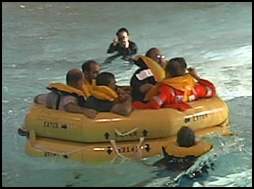 Hoover provided one of their new FR-6, six-person, Type I, reversible (meaning it has no top or bottom) rafts. The company declined to provide pricing for the raft supplied. Subsequent to our evaluation they have introduced a 4-person version of this raft.
Hoover provided one of their new FR-6, six-person, Type I, reversible (meaning it has no top or bottom) rafts. The company declined to provide pricing for the raft supplied. Subsequent to our evaluation they have introduced a 4-person version of this raft.
Our volunteer testers struggled to board the raft via the same two-rung boarding ladder used on the single-tube rafts with only a couple of handholds to assist. It proved impossible for one of our volunteers to board unassisted as it kept flipping over as she tried in vain to climb in.
The floor is slung between the two tubes, sagging considerably, providing a sloping floor that made it difficult to maintain a sitting position at the tube. The three token ballast bags (80 lbs. total) on each side and rudimentary drogue are virtually worthless.
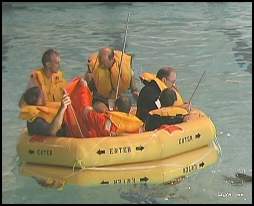 The canopy, as on the single-tube Hoover rafts, was a puzzle for our volunteers, who took nearly a half-hour to erect it, even with some hints, and even then it wasn't entirely correct. The central aluminum mast poked holes in the floor. When the raft was capsized - very easily as you might expect - the ensuing jumble of rods made for a potentially lethal situation under the raft and a number of the canopy support rods were bent, making re-erection more difficult. The canopy proved virtually useless under assault of the fire hose.
The canopy, as on the single-tube Hoover rafts, was a puzzle for our volunteers, who took nearly a half-hour to erect it, even with some hints, and even then it wasn't entirely correct. The central aluminum mast poked holes in the floor. When the raft was capsized - very easily as you might expect - the ensuing jumble of rods made for a potentially lethal situation under the raft and a number of the canopy support rods were bent, making re-erection more difficult. The canopy proved virtually useless under assault of the fire hose.
The SEP is tethered to the raft and had to be retrieved from where it was trapped underneath; poor placarding didn't help. We had to empty virtually the entire contents, risking their loss, to get to the canopy. The sea dye in the SEP leaked over the contents and would have made a real mess in the raft had we not removed the SEP immediately after deployment. Hoover continues to use old-fashioned topping valves, and true to form, one was closed so tightly during the testing that it proved impossible to open without mechanical assistance, which was not provided.
Eastern Aero Marine
 Eastern Aero Marine offers approved 6- and 12-person Type I double-tube rafts that we have not tested. In most respects they are similar to their T-series single-tube approved rafts and we expect performance to be no better than the nearly identical Hoover FR-6.
Eastern Aero Marine offers approved 6- and 12-person Type I double-tube rafts that we have not tested. In most respects they are similar to their T-series single-tube approved rafts and we expect performance to be no better than the nearly identical Hoover FR-6.
At NBAA in October 2000, EAM introduced its new "Alpha" series of life rafts. Among these were TypeII rafts with self-erecting single-arch canopies, modest ballast bags and more sophisticated entry aids among their features. These rafts show considerable promise compared to the anachronisms that EAM has sold for so long. On the other hand, we must caution that we have discovered the hard way that there is a big difference between first impressions and actual performance, Air Cruisers being a prime example.
RFD/Revere
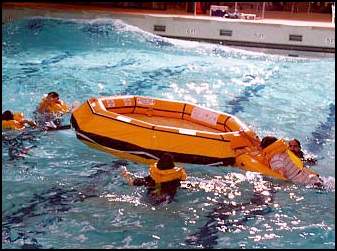 The RFD/Revere "R" series approved rafts are reversible and have some unique features that set them apart. This raft was originally developed specifically for helicopters used in the North Sea oil fields and RFD calls it a "Heliraft." In order to meet the unique requirements of this industry, it was deemed necessary to change some of the requirements in the CAA (U.K. counterpart to the FAA) Specifications (counterpart to the FAA's TSO). The specification was amended to accommodate the changes in an appendix titled "Helicopter Liferafts." Included is this rational for the compromises and changes: "a basic consideration is that helicopter over water operations are relatively short range.... The time survivors are likely to spend in liferafts after a helicopter ditching is therefore envisaged to be limited." That might not be the case with fixed-wing aircraft.
The RFD/Revere "R" series approved rafts are reversible and have some unique features that set them apart. This raft was originally developed specifically for helicopters used in the North Sea oil fields and RFD calls it a "Heliraft." In order to meet the unique requirements of this industry, it was deemed necessary to change some of the requirements in the CAA (U.K. counterpart to the FAA) Specifications (counterpart to the FAA's TSO). The specification was amended to accommodate the changes in an appendix titled "Helicopter Liferafts." Included is this rational for the compromises and changes: "a basic consideration is that helicopter over water operations are relatively short range.... The time survivors are likely to spend in liferafts after a helicopter ditching is therefore envisaged to be limited." That might not be the case with fixed-wing aircraft.
It is also worth noting that both pilots and passengers in North Sea and most other similar offshore oil operations are required to receive considerable water survival training including training in the use of the life raft. Training can overcome many otherwise significant drawbacks. They are also required to wear survival exposure/floatation suits and thus are already in better shape after a ditching than typical GA pilots and passengers.
The raft is an octagonal double-tube design with the single-layer floor placed between the two 10-inch tubes (on the 7-person) instead of at the bottom, giving only the equivalent of a small single-tube raft's backrest. Construction is of bright yellow PCF. A semi-rigid boarding ramp is provided at the primary entry on the 7-person raft we tested. The entry is comprised of a splayed "U"-shaped buoyancy tube which sticks out from the raft and which is hinged at the attachment point. Between the tubes is a nylon open mesh material which provides relatively non-slip purchase.
In general, it is relatively easy for even a weak or injured person to pull themselves up the ramp and into the raft, resting on the ramp if necessary. However, we noted that with very heavy survivors, under some circumstances, the ramp's buoyancy may be overcome, leaving the survivor with little or no leverage against which to push, making boarding very difficult to nearly impossible unassisted. Eight-person and larger rafts have boarding ramps at both entries.
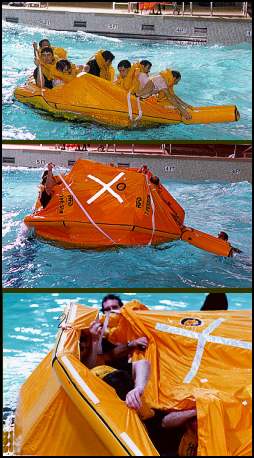 The RFD canopy is a mixed blessing. It was spacious and very weatherproof, but it is not automatically erected. Upon inflation, the two parallel canopy arches are inflated, each around the outside of the main buoyancy tubes. They are held in place by a Velcro'd cover and serve as a sort of bumper, protecting the main tubes. Unfortunately, erecting the canopy is not intuitive and the instructions, a placard on the side of the tube, can be easily hidden by the survivors filling the raft. Testers were unaware that there was a canopy and made no attempt to find and erect it, even though they had erected canopies on all other rafts.
The RFD canopy is a mixed blessing. It was spacious and very weatherproof, but it is not automatically erected. Upon inflation, the two parallel canopy arches are inflated, each around the outside of the main buoyancy tubes. They are held in place by a Velcro'd cover and serve as a sort of bumper, protecting the main tubes. Unfortunately, erecting the canopy is not intuitive and the instructions, a placard on the side of the tube, can be easily hidden by the survivors filling the raft. Testers were unaware that there was a canopy and made no attempt to find and erect it, even though they had erected canopies on all other rafts.
When all who might have to use the raft have been trained, this isn't a problem. Unfortunately, in normal GA operations that is the exception rather than the rule. In addition, while the boarding ramp makes it easier for an injured survivor to get on board, it is unlikely a single injured survivor with only one usable hand will erect the canopy, even if they know how. Quick exit in case of overturning could also be hampered by the canopy design.
We had other concerns as well. The raft depends upon "suction" for stability. That may not suffice in breaking crests or very heavy seas. With only one person on board, we noted "air" under the leading edge in our wave test, and with only a single person on board the raft was easy to overturn. If the bottom cell is lost, there is little or no suction and repairs could be difficult since it is hard to access the deflated lower cell. If the top cell is lost, there is very little left to keep you in the raft; you are essentially sitting on a platform retained only by the minimal height and bulk of the canopy arches, if not erected. With the canopy erected, you are in somewhat better shape, but repairs to the exterior of the main upper tube could require lowering the canopy to reach them. Not the best situation we can envision.
We tested all lines and attachment points on all rafts as best we could. The RFD was the only production raft on which we experienced a significant failure. The narrow inside grab line was ripped from its attachment point.
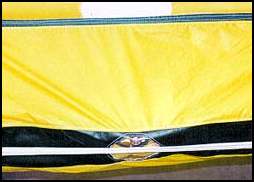 There is also no interior canopy light and the exterior locator light is on the side of the raft, mostly shielded and ineffective, until the canopy is raised, and appears to not meet the TSO viewing requirements.
There is also no interior canopy light and the exterior locator light is on the side of the raft, mostly shielded and ineffective, until the canopy is raised, and appears to not meet the TSO viewing requirements.
An optional auto-deploying 121.5 MHz ELT was included, but the strip antenna is attached to a canopy arch. The ELT manufacturer, Artex, says that while the ELT signal would certainly be picked up by an aircraft overhead, they couldn't guarantee it would be picked up by a satellite unless the antenna was more or less vertical. Even erected, the arch is at a relatively steep angle. In other words, operation of the ELT is compromised and it really isn't an effective auto-deploying ELT.
The instructions for inflation on the valise were not easy to find and were confusing. The spring clip on the mooring/inflation line is so stiff, some volunteers were unable to readily attach it. Not everyone is an oil-field worker. The manual inflation pump was very difficult to use. The SEP is in a plastic bag attached to the raft with a tether and has to be retrieved by survivors.
The RFD "R" series is available in five- through ten- and 12- through 18-person capacity. Revere failed to respond to our numerous calls and emails seeking current pricing. Previously, they have said the "price is negotiated depending upon the valise style" and other details.
RFD/Revere also offer a more conventional "Aerolite" series of Type I life rafts with auto-erecting single arch canopies. So far we have been unable to obtain one of these rafts to test.
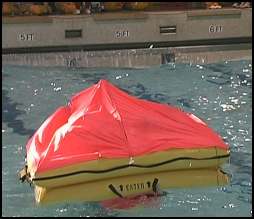 SurvivalProducts Inc.
SurvivalProducts Inc.
We obtained a sample of Survival Products' six-person Type I raft. Subsequently, they have also certified a 10-person Type I of the same design.
The double-tube raft is similar in most respects to their single-tube Type II offering with the same equipment and features, except with two tubes. There are two of the same size ballast bags on opposite sides of the raft at the entry points that served minimally for boarding purposes, but are otherwise inadequate. Boarding aids consist of a single loop of one-inch webbing for a step, the lifelines, and a grab handle on the upper tube, making boarding over the double 9.5-inch tubes difficult at best and impossible for some unassisted, a significant failing.
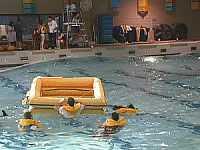 With more headroom and back support, the manually-erected canopy was somewhat more comfortable, but only relatively. It still collapsed, leaked water through both entries and the bottom, and it tore when the raft capsized.
With more headroom and back support, the manually-erected canopy was somewhat more comfortable, but only relatively. It still collapsed, leaked water through both entries and the bottom, and it tore when the raft capsized.
As with the single-tube raft, capsizing was a cinch. The larger valise cum drogue got caught up on its Velcro immediately almost every time we tried it and was nearly impossible to keep functioning as it was very prone to this due to its longer length.
Winslow LifeRaft Company
Winslow's unapproved model FADR "Super-Light DualSafe" (at one time referred to as the "basic" model of the FAAV) provides an option for the GA pilot who prefers full redundancy without all the extra weight of a fully-equipped double-tube raft. This is, essentially, their decagonal, double-tube, approved FAAV Ultima life raft less the canopy, inflatable floor, storage bags and numerous other "nice-to-have," but not essential, features. It has the same effective tri-ballast as the GAST and Winslow's excellent boarding aids, righting line and light. It is equipped with the same raft equipment and the well-stocked Basic General Aviation SEP as on the Island Flyer. It is available in 4- and 13-person sizes.
Winslow tells us many pilots have started with the standard DualSafe and then customized it to suit their particular requirements. One nice feature of the FADR is that the owner can return the raft to Winslow after purchase and add most available options, such as a canopy, at a later date, upgrading the raft as their situation or risk evaluation changes.
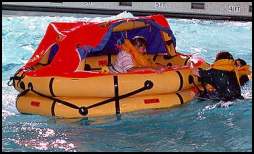 The four- and 12-person approved "FASL Super-Light Ultima" rafts we tested are improved versions of their former top-rated FA-AV. These decagonal double-tube rafts have an auto-erecting, stay-erect tri-arch canopy that provided adequate headroom over most of the interior except at the center of the entry. The rafts are available with a wide variety of SEPS and Winslow's usual slew of options, though fewer than their other rafts since so much is standard.
The four- and 12-person approved "FASL Super-Light Ultima" rafts we tested are improved versions of their former top-rated FA-AV. These decagonal double-tube rafts have an auto-erecting, stay-erect tri-arch canopy that provided adequate headroom over most of the interior except at the center of the entry. The rafts are available with a wide variety of SEPS and Winslow's usual slew of options, though fewer than their other rafts since so much is standard.
With the Sure-Seal storm flaps the canopy proved very weather-tight. The observation port/water collection tube on all Winslows is now fitted with Velcro'd covers/restraints to help limit unwanted water entry, a problem previously.
Winslow's entry aids, identical to that of the GAST Island Flyer, are supplemented on the double-tube rafts with a longer ladder, additional grab handles, and "stirrups" on the bottom tube, resulting in a raft everyone could board with minimal difficulty, despite the enormous freeboard. Winslow's "Pentagonal" ballast system (83 lbs. ea., 415 lbs. total) remains the most effective on any aviation raft, by a large margin, and coupled with the most effective drogue the result is superior capsize resistance. A 50% larger "Cape Horn" ballast system is an available option ($87) for those seeking even larger survival margins. The drogue is Winslow's industry leading hemispherical parachute with swivels.
Winslow continues with their commodious, industry-leading storage bags; five are included. The other well-thought-out features we liked in the GAST Island Flyer were all here, the inflatable floor is standard. Also fitted were prototypes of a DME Corporation-manufactured auto-deploying 406 MHz ELT being developed to replace the current 121.5 MHz unit. Winslow's intention is to include the 406 as standard equipment on TSO'd rafts. Initial deliveries were scheduled for end of the year 2000, but DME has not delivered as promised. It is still Winslow's intention to phase out the 121.5 MHz ELTs for 406 MHz as soon as the equipment is available.
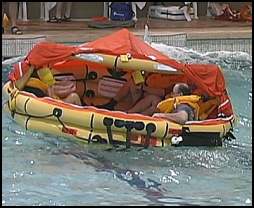 Winslow also sent us a four- and a 12-person "FAUL Ultra-Light." These are evolutions, or perhaps we should say "devolutions," of the Ultima. With the big-iron manufacturers insisting on lighter weight rafts, Winslow "made compromises to save weight where they would least affect survivability while retaining the features of the Ultima the pilots and crew told us were most important to them," claimed Winslow's Gerard Pickhardt.
Winslow also sent us a four- and a 12-person "FAUL Ultra-Light." These are evolutions, or perhaps we should say "devolutions," of the Ultima. With the big-iron manufacturers insisting on lighter weight rafts, Winslow "made compromises to save weight where they would least affect survivability while retaining the features of the Ultima the pilots and crew told us were most important to them," claimed Winslow's Gerard Pickhardt.
Canopy material was changed from the heavier dual-color material to the industry-standard semi-transparent orange ripstop nylon. The buoyancy tubes were made smaller, reducing freeboard and reserve freeboard significantly, a notable reduction in overall capability. That had the salutary side effect of increasing interior space to nearly 4 sq. ft. per person. Lifelines were changed to one-inch webbing from the standard two-inch, but two-inch is retained for all the boarding and righting aids. Storage bag material was changed to a lighter weight. A smaller cylinder is needed with less volume to fill. In all other respects the rafts remain the same. The UL does flex more in waves than the very rigid Ultima due to the smaller tubes.
Those highly-regarded view ports are an available option on the approved rafts, well worth the $450 in our opinion. Both TSO'd rafts are available in 2- through 13-person sizes by single increments and beginning in May now have a two-year service interval for the initial four years, yearly thereafter.
Comparisons
| Manufacturer/Model | Rated Capacity | Price USD* | Weight (lbs.)* | Boarding Rating** | Stability Rating*** | |
| Air Cruisers | 4 | $6,900 | 38.8 | Fair | Fair | |
| Air Cruisers | 13 | $9,800 | 71.8 | Failed | Poor | |
| BFGoodrich | 4 | $6,811 | 41.2 | Very Good | Fair | |
| BFGoodrich | 12 | $9,512 | 69.4 | Very Good | Failed****** | |
| Hoover FR-6 | 6 | NA**** | 56.2 | Failed | Very Poor | |
| RFD/Revere R Series | 7 | NA***** | 70.2 | Fair | Poor | |
| Survival Products RAF1206-105 | 6 | $4,220 | 41 | Failed | Poor | |
| Winslow Ultima FAAV | 4 | $6,270 | 54.4 | Very Good | Excellent | |
| Winslow Ultima FAAV | 12 | $9,240 | 92 | Very Good | Good | |
| Winslow Ultra-Light FAUL | 4 | $6,920 | 42 | Very Good | Excellent | |
| Winslow Ultra-Light FAUL | 10 | $8,012 | 67.4 | Very Good | Good | |
| Winslow Ultra-Light FAUL | 12 | $10,247 | 74.8 | Very Good | Good | |
| * As tested including: valise, Part 135 SEP w/ ELT and PUR-06, except as noted in text (Prices as of 02/28/00) ** Boarding aids, placarding, boarding tests *** Ballast, sea anchor, sea anchor tests, capsize tests **** Hoover declined to provide a price, saying only that rafts were available from $2,600 and up ***** Revere failed to return calls, previously declared "price is negotiated" ****** Drogue line attachment point failure, otherwise Fair |
||||||
Conclusions
Survival Products...
![]() With Survival Products "you get what you pay for," noted one tester. While not necessarily always the case, you rarely get more than you pay for and such is the case with the SPI rafts. They meet the letter of the regulations, and if that is your sole concern, they are the least expensive way to get an approved Type I raft.
With Survival Products "you get what you pay for," noted one tester. While not necessarily always the case, you rarely get more than you pay for and such is the case with the SPI rafts. They meet the letter of the regulations, and if that is your sole concern, they are the least expensive way to get an approved Type I raft.
Unfortunately, the Survival Products Type I raft is a bust. Unseaworthy, in our opinion, it would be a poor choice for any serious overwater flying. Aside from seaworthiness issues, if you can't get in the raft, it doesn't do you much good. Wrote one volunteer, "it may be cheap and it may even meet the regs, but my life is worth more than that."
...Hoover...
![]() For a company that has developed some truly innovative life vests, it's hard to fathom why Hoover would introduce a new raft based on obsolete technology - except maybe to compete with EAM's equivalent antiquated product. One volunteer summed up the consensus opinion, "save yourself, forget the raft." We consider it among the worst approved rafts we've ever tested.
For a company that has developed some truly innovative life vests, it's hard to fathom why Hoover would introduce a new raft based on obsolete technology - except maybe to compete with EAM's equivalent antiquated product. One volunteer summed up the consensus opinion, "save yourself, forget the raft." We consider it among the worst approved rafts we've ever tested.
...Air Cruisers...
 Air Cruisers' rafts were a big disappointment; we expected better. They appear to have thrown out the baby with the bath water in the quest for their Holy Grail of lighter weight and low cost. Asked one tester, "what use is saving a few pounds if it won't save your life?" The canopy zipper failures are inexcusable, not something that could not be foreseen given the lightweight hardware. Again, some testers couldn't board, a very serious failure as well.
Air Cruisers' rafts were a big disappointment; we expected better. They appear to have thrown out the baby with the bath water in the quest for their Holy Grail of lighter weight and low cost. Asked one tester, "what use is saving a few pounds if it won't save your life?" The canopy zipper failures are inexcusable, not something that could not be foreseen given the lightweight hardware. Again, some testers couldn't board, a very serious failure as well.
Their three-year interval for the PUR 06, in contravention of the manufacturer's recommendation, also concerns us. We're also not thrilled about the grossly extended service interval for the raft itself, irrespective of their claims and representations regarding the other services required. On the marine side we recently discovered a situation where a potentially life-threatening defect in one manufacturer's rafts wasn't discovered until years down the road solely because of extended service intervals. Our concern is heightened by the apparent lapses in quality control, the too-short tether on the raft knife and mismatched pump on the 13-person being but two scary examples. Given these and many other shortcomings we found, we cannot recommend the Air Cruisers rafts at this time.
...RFD/Revere...
 The unique RFD/Revere "R" series rafts have significant drawbacks for most GA use. Some features, such as the locator light, clearly don't meet the TSO, though those issues are minor compared to other concerns. It is the raft's genesis, the optimization for the off shore helicopter environment, that creates the most serious problems. For off-shore helicopter use, for which it was designed, or where full training is available, such as military use, it may be acceptable. However, we do not think it is the best choice when the survival situation might involve those who have not received training in the use of the raft and that covers most GA use.
The unique RFD/Revere "R" series rafts have significant drawbacks for most GA use. Some features, such as the locator light, clearly don't meet the TSO, though those issues are minor compared to other concerns. It is the raft's genesis, the optimization for the off shore helicopter environment, that creates the most serious problems. For off-shore helicopter use, for which it was designed, or where full training is available, such as military use, it may be acceptable. However, we do not think it is the best choice when the survival situation might involve those who have not received training in the use of the raft and that covers most GA use.
...BFGoodrich...
 The BFGoodrich rafts remain a mixed bag. We like a number of their features, including the comfort and headroom. The entry system proved effective, at least the equal and potentially even better than Winslow's. The 4-person is a moderately capable raft. The 12-person raft was very comfortable, but we remain concerned about the lack of adequate ballast.
The BFGoodrich rafts remain a mixed bag. We like a number of their features, including the comfort and headroom. The entry system proved effective, at least the equal and potentially even better than Winslow's. The 4-person is a moderately capable raft. The 12-person raft was very comfortable, but we remain concerned about the lack of adequate ballast.
The drogue failure was disturbing. With hand-built products such a life raft it is inevitable that some assembly errors will occasionally occur, but construction quality has never seemed to be a problem with BFG. The attachment point failure, combined with other less serious indications of poor quality control in the larger raft's construction, leave us wondering if BFGoodrich's move to build these rafts offshore, in India, was a very good idea.
...And Winslow
Obviously not content to rest on their laurels, Winslow continues to lead the industry in performance and features, and surprisingly, seems to be widening the gap despite increased competition. Their overall quality, performance, and consideration of human factors made a strong impression, as one tester noted, "somebody actually thought about the people who might use this raft."
 The Winslow Ultima and Ultra-Light garnered every vote for "Best Aviation Raft" from our testers who included both "life raft virgins," who had never been in a life raft before, and experienced survival instructors and SAR personnel from both the U.S. and Europe. Receiving the majority of those votes, and we concur, the aptly named Ultima is still Best Overall in our opinion, and even better than last we reviewed it. While not perfect, nothing else, except their own Ultra-Light, comes close.
The Winslow Ultima and Ultra-Light garnered every vote for "Best Aviation Raft" from our testers who included both "life raft virgins," who had never been in a life raft before, and experienced survival instructors and SAR personnel from both the U.S. and Europe. Receiving the majority of those votes, and we concur, the aptly named Ultima is still Best Overall in our opinion, and even better than last we reviewed it. While not perfect, nothing else, except their own Ultra-Light, comes close.
We were a bit disappointed to see Winslow compromise its ultimate performance to produce the Ultra-Light, particularly the reduced freeboard. On the other hand, it's a boon for safety-conscious single and piston twin pilots where weight is generally a legitimate concern. The Ultra-Light offers a huge increase in safety margin over the GAST without the weight penalty of the full-blown Ultima, making it a great compromise for those who prefer the extra margin of safety from a double tube raft-and can afford the premium price.
Winslow's move to a standard self-deploying 406 MHz beacon is a major step forward; it'll get you rescued quicker than just about anything except ditching beside a Coast Guard cutter, and that, after all, is the ultimate goal. DME's failure to deliver on time is a big disappointment. Winslow's view ports are a "must-have" option.
|
Editor's Note This article is the final installment of a four-part series, the previous portions of which were published over the preceding six weeks. |
|
Many more details on the life raft testing and the individual life rafts can be found on Doug Ritter's Equipped to Survive web site. The Equipped To Survive site is also the largest online resource for information on ditching and water survival. |


